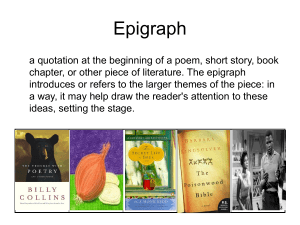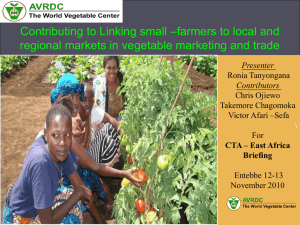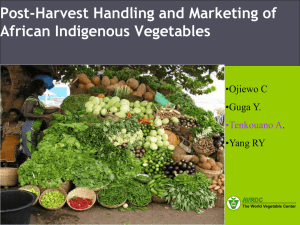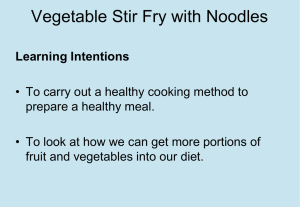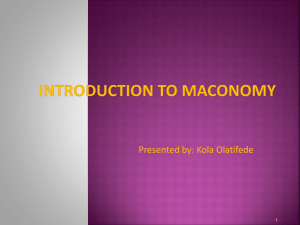PowerPoint 簡報
advertisement
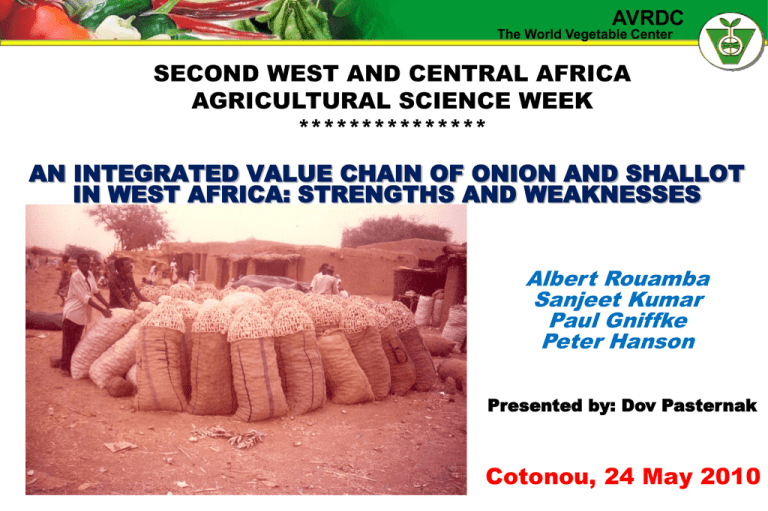
AVRDC The World Vegetable Center SECOND WEST AND CENTRAL AFRICA AGRICULTURAL SCIENCE WEEK *************** AN INTEGRATED VALUE CHAIN OF ONION AND SHALLOT IN WEST AFRICA: STRENGTHS AND WEAKNESSES Albert Rouamba Sanjeet Kumar Paul Gniffke Peter Hanson Presented by: Dov Pasternak Cotonou, 24 May 2010 AVRDC The World Vegetable Center Contents 1. Onion in the world, Africa and West Africa 2. Onion and shallot value chain 3. Analyze of the components of onion and shallot value chain 4. Interactions and links between the actors of the value chain 5. Strengths and weaknesses 6. Recommendations AVRDC The World Vegetable Center Statistics of onion production Region/country Production (t) West Africa 1.200.000 Nigeria 621.000 Niger 373.000 Burkina Faso na Senegal 145.000 *Mali 38.000 Source: FAOSTAT, 2008; available Areas (ha) Yield (t/ha) 65.585 18,3 42.000 14,8 10.500 35,5 na na 5.200 27,9 1.800 21,1 *= only shallot; na= not AVRDC The World Vegetable Center Characteristics of onion and shallot chain Low degree of organization Limited cooperation, High transactional costs, Unfair markets, Significant post harvest loss, Un-trained actors, Insufficient use of research results Absence of use of improved storage facilities, Poor road networks Insufficient transport facilities leading to loss of the product value AVRDC The World Vegetable Center Analyze of the components of onion and shallot value chain Components of onion and shallot value chain and flow of goods and services AVRDC The World Vegetable Center Research Generator of technologies Performing varieties : Foundation seeds, certified seeds (Violet de Galmi, V28, FBO1, V13, AC980…. Development of good cultural practices Development of best storage structures and bulb management Training Bulb production to High value Headquarter of ISRA AVRDC The World Vegetable Center AVRDC The World Vegetable Center Input supply Seeds Fertlizers Crop protection products Tool/equipment suppliers Bags Good seeds Bad seeds AVRDC The World Vegetable Center Productions Period: October to April Zones: Arid and semi-arid zones in preference Total production: 1.2 million of tons Yield (t/ha): 18 tons for onion Biggest producers: Nigeria and Niger AVRDC The World Vegetable Center Storage and processing Onion is perishable but could be saved up to 6-8 months with a loss rate of 20% IF Good seeds are used Good cultural practices used Good technical harvest and post harvest techniques used Bulb store in good storage structures and correctly manage 80% of bulbs could be saved AVRDC The World Vegetable Center Development of storage structures of onion considerably reduce the looses after harvest in West Africa Traditional shed can store 2-7 tons Improved shed about 5 to 10 tons, type ISRA-Senegal Improved house for bulbs storage AVRDC The World Vegetable Center Development of storage structures of onion considerably reduce the looses after harvest in West Africa (Ctd) Improved house for bulbs storage at 50-100 tones Industrial type for bulb storage at 500 tones Performances of these structures are conditioned by the quality of produced bulbs AVRDC The World Vegetable Center Processing allows to reduce also the looses after onion harvest Bulbs are sliced and dried Bulbs crushed, dried and ground AVRDC The World Vegetable Center Export, import and transporation Onion is a factor of regional integration Producing countries Consumer countries Import from: EU+Egypt Legend: Shallot: Onion: Marketing intra-regional channels of onion and shallot in West Africa 70% AVRDC The World Vegetable Center Relationship between the actors Absence or weak dialogue Interest group: loans, inputs Limited profits and cohesion fragile. Lack of professionalism 30% of the added value is generated by the product MARKET PRODUCTION 70% 30% 70% of the added value is generated by the market Distribution of the added value between the market and production. AVRDC The World Vegetable Center Strengths The intra-regional trade of onion and shallot constitutes a powerful tool for economic integration Onion is the most important source of incomes for most farmers, notably the smallholders, and improves the livelihoods of the poorest, women and young. The onion and shallot processing is exclusively for women who are more affected by unemployment AVRDC The World Vegetable Center Weaknesses The informal nature of relationship among the actors, inadequate capacity of organizations, limited access to formal credit and poor investment on productivity and profit enhancement The poor social and physical infrastructures (like roads) in the region exacerbate the risks associated with marketing and increased costs of transportation to the destination. The lack of organization market and forces the producers to sell their products to the traders at a low and unpaid cost The ignorance or the insufficient use of agricultural research results constitutes serious barriers to the value chain of onion and shallot promotion 70% AVRDC The World Vegetable Center Recommendations Today Tomorrow 30% of the added value is generated by the product 70% of the added value is generated by the product PRODUCTION MARKET PRODUCTION MARKET 30% 70% 70% 30% 70% of the added value is generated 30% of the added value is generated by the market by the market The trend should be reversed like this Distribution of the added value between the market and production. AVRDC The World Vegetable Center Recommendations The recommendations aim to lead the producers to acquire a force capable of reversing the trend. For that, farmers have to: - Produce their own quality seed and comply with good agricultural practices to submit onions and shallots unbeatable. - Generalize the use of technical performances of storage and processing of onions and shallots in order to make available in markets processed products or not according to demand while keeping prices at remunerative levels. AVRDC The World Vegetable Center
